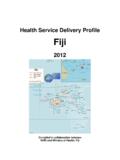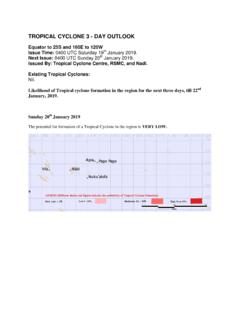Transcription of FINANCIAL SECTOR DEVELOPMENT AND REFORM IN FIJI
1 FINANCIAL SECTOR DEVELOPMENT ANDREFORM IN FIJIC aroline WaqabacaWorking Paper2000/05 September 2000 Economics DepartmentReserve Bank of FijiSuvaFijiThe views expressed herein are those of the author and do not necessarilyreflect those of the Reserve Bank of fiji . The author expresses her thanksto Steven Morling and Jitendra Singh for their the early 1980s, fiji has undergone a gradual process offinancial system REFORM . This paper provides a brief description of fiji sfinancial SECTOR and describes chronologically the FINANCIAL SECTOR , fiji s FINANCIAL system is reasonably towards a more developed FINANCIAL system is inevitable inlight of continuing developments domestically and internationally.
2 Withinthis context, an important challenge is to properly integrate these financialsystem changes. This underscores the call to pursue an efficient andeffective FINANCIAL IntroductionFinancial SECTOR liberalisation can be defined as a set of reforms andpolicy measures designed to deregulate and transform the FINANCIAL systemand its structure with a view to achieving a liberalised market-orientedsystem within an appropriate regulatory framework. The success offinancial SECTOR REFORM throughout the world has seen the introduction ofmarket-based procedures for monetary control, the promotion ofcompetition in the FINANCIAL SECTOR , and the relaxation of restrictions oncapital , the move away from a tightly controlled FINANCIAL sectorto a deregulated one results in greater flexibility in interest rates,enhancement of the role of markets in credit and foreign exchangeallocation, increased autonomy for commercial banks.
3 Greater depth ofmoney, securities, and foreign exchange markets, and a significant increasein cross-border capital objective of bringing about these changes to the FINANCIAL systemis to create more efficient and stable systems, which will facilitate betterperformance in the economy. This means providing a foundation forimplementing effective stabilization policies and successfully mobilizingcapital and putting it to efficient use, which leads to achieving higher ratesof economic have been done to analyse the extent of financialintermediation in an economy as an important determinant of its realgrowth rate.
4 Empirical results for a large sample of countries confirm that 1 Johnston R. B. and Sundararajan V. Managing FINANCIAL SECTOR Liberalisation: An overview . p13financial variables have an important impact on economic growth. Manycountries have experienced successful FINANCIAL SECTOR reforms which havebeen accompanied by improvements in economic growth and efficiencywhile other countries have faced FINANCIAL crisis and disruptions toeconomic in the early 1980s, fiji s FINANCIAL system began to bederegulated and by the mid-1980s, substantial changes had taken place inthe system structure.
5 Consistent with trends in other developing countries,institutions and markets are growing and developing, leading to anincreasing role being played by the FINANCIAL system in the DEVELOPMENT ofFiji s paper provides a description of the FINANCIAL system in fiji andan outline of reforms that have been undertaken and some concludingcomments. Section 2 of the paper provides a brief description of financialinstitutions in fiji . Section 3 gives an account of FINANCIAL SECTOR REFORM inFiji. Section 4 concludes the paper.
6 An appendix provides a chronology offinancial SECTOR The FINANCIAL System in FijiFiji s FINANCIAL system has continued to grow over the years andplays a vital role in the economy by mobilising FINANCIAL savings andchanneling these into productive in the FINANCIAL SECTOR during the past 1/2 decades hasbeen clearly evident in the growth in total assets of FINANCIAL assets of the FINANCIAL SECTOR in 1982, were $ billion4compared with over $ billion in 1998, a tremendous growth of over FINANCIAL system today (excluding the Reserve Bank of fiji )comprises Licensed FINANCIAL Institutions (LFIs) and other Non-BankFinancial Institutions (NBFIs), accounting for 47 percent and 53 percentrespectively of total FINANCIAL SECTOR include 7 banks, 3 credit institutions and 14 insurancecompanies while Other NBFIs comprise the fiji National Provident Fund(FNPF), the fiji DEVELOPMENT Bank (FDB), Housing Authority (HA), UnitTrust of fiji (UTOF)
7 And National MBf Finance ( fiji ) Limited (MBf).Activities of banks and insurance companies are regulated under theBanking Act and the Insurance Act respectively. NBFIs authorised toaccept deposits from the public are also supervised under the Banking Act these institutions are termed credit activity in fiji is dominated by two major banks, the Australiaand New Zealand Banking Group Limited and the Westpac BankingCorporation, both branches of foreign banks. These 2 banks have been inexistence in fiji throughout the REFORM period.
8 Two other banks are fairlyrecent Habib Bank Limited and Bank of Hawaii began banking businessin the country in 1991 and 1993 respectively. Other banks include theBank of Baroda, which has its headquarters in India, the Asset ManagementBank and the Colonial National Bank. The two latter banks were formerlytogether as the National Bank of fiji (NBF) prior to its split into 2 separateentities in in total gross assets of the banking SECTOR has beentremendous from $400m in the early 1980s to $1,841m in 1998. This5continues to be reflected in the profitability levels maintained by banks andtheir success in containing operating expenses.
9 Recent reductions in bankcosts have been attributed to the rationalisation of branch networks,centralising back office functions and the implementation of institutions have also gained growing importance in thecountry s FINANCIAL system with their percentage share in total financialsector assets increasing to percent ($160m) of the total in 1998 fromonly percent in 1995. These licensed institutions also accept depositsfrom the public but differ from banks in that they are not authorised toaccept demand deposits withdrawable by cheque.
10 Credit institutions in thissector include the Merchant Bank of fiji , which was granted a license tooperate in 1992 and is in the business of mostly financing purchases ofmachinery, equipment and vehicles. Credit Corporation ( fiji ) Limited isanother licensed credit institution which has almost 70 percent foreignownership by Credit Corporation (PNG) Limited, specialising in short-termequipment and vehicle finance. Home Finance Company Limited wasestablished in 1961 to provide housing loans to middle and upper incomegroups and became a credit institution in , there are 14 insurance companies and brokers licensedunder the provisions of the Insurance Act of 1998, which came into effecton 1 January 1999.









